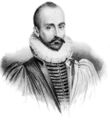Template:Selected anniversaries/February 28: Difference between revisions
No edit summary |
No edit summary |
||
| Line 89: | Line 89: | ||
||1960: Teiji Takagi dies ... mathematician, best known for proving the Takagi existence theorem in class field theory. The Blancmange curve, the graph of a nowhere-differentiable but uniformly continuous function, is also called the Takagi curve after his work on it. Pic. | ||1960: Teiji Takagi dies ... mathematician, best known for proving the Takagi existence theorem in class field theory. The Blancmange curve, the graph of a nowhere-differentiable but uniformly continuous function, is also called the Takagi curve after his work on it. Pic. | ||
||1966: The 1966 NASA T-38 crash occurred when a NASA Northrop T-38 Talon crashed at Lambert Field in St. Louis, Missouri, on February 28, 1966, killing two Project Gemini astronauts, Elliot See and Charles Bassett. The aircraft, piloted by See, crashed into the McDonnell Aircraft building where their Gemini 9 spacecraft was being assembled. The weather was poor with rain, snow, fog, and low clouds. A NASA panel, headed by the Chief of the Astronaut Office, Alan Shepard, investigated the crash. While the panel considered possible medical issues or aircraft maintenance problems, in addition to the weather and air traffic control factors, the end verdict was that the crash was caused by pilot error. Pic. | ||1966: The 1966 NASA T-38 crash occurred when a NASA Northrop T-38 Talon crashed at Lambert Field in St. Louis, Missouri, on February 28, 1966, killing two Project Gemini astronauts, Elliot See and Charles Bassett. The aircraft, piloted by See, crashed into the McDonnell Aircraft building where their Gemini 9 spacecraft was being assembled. The weather was poor with rain, snow, fog, and low clouds. A NASA panel, headed by the Chief of the Astronaut Office, Alan Shepard, investigated the crash. While the panel considered possible medical issues or aircraft maintenance problems, in addition to the weather and air traffic control factors, the end verdict was that the crash was caused by pilot error. Pic. | ||
| Line 111: | Line 109: | ||
||2014: Lee Lorch dies ... mathematician and activist. Pic search. | ||2014: Lee Lorch dies ... mathematician and activist. Pic search. | ||
</gallery> | </gallery> | ||
Revision as of 11:31, 21 January 2022
1533: Philosopher and author Michel de Montaigne born. He will be one of the most significant philosophers of the French Renaissance, known for popularizing the essay as a literary genre.
1552: Clockmaker and mathematician Jost Bürgi born. He will be recognized during his own lifetime as one of the most excellent mechanical engineers of his generation.
1901: Chemist, biochemist, peace activist, author, and educator Linus Pauling born.
- 1958 RAF Greenham Common accident (no image)
1958 RAF Greenham Common accident: a B-47E of the 310th Bomb Wing developed problems shortly after takeoff and jettisoned its two 1,700 gallon external fuel tanks. They missed their designated safe impact area, and one hit a hangar while the other struck the ground 65 feet (20 m) behind a parked B-47E. The parked plane, which was fuelled, had a pilot on board, and was carrying a 1.1 megaton (4.6 PJ) B28 nuclear bomb, was engulfed by flames. The conflagration took sixteen hours and over a million gallons of water to extinguish, partly because of the magnesium alloys used in the aircraft. Although two men were killed and eight injured, the US and UK governments kept the accident secret: as late as 1985, the British government claimed that a taxiing aircraft had struck a parked one and that no fire was involved. Two scientists, F. H. Cripps and A. Stimson, who both worked for the Atomic Weapons Research Establishment at Aldermaston, stated in a secret 1961 report, released by the CND in 1996, that the fire detonated the high explosives in the nuclear weapon, that plutonium and uranium oxides were spread over a wide area (foliage up to 8 mi (13 km) away was contaminated with uranium-235) and that they had discovered high concentrations of radioactive contamination around the air base.[4] However, a radiological survey commissioned in 1997 by Newbury District Council and Basingstoke and Deane found no evidence of a nuclear accident at Greenham Common, suggesting that Cripps and Stimson's statements were false.


